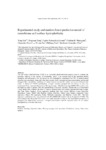Mostrar o rexistro simple do ítem
Experimental study and random forest prediction model of microbiome cell surface hydrophobicity
| dc.contributor.author | Liu, Yong | |
| dc.contributor.author | Tang, Shaoxun | |
| dc.contributor.author | Fernández-Lozano, Carlos | |
| dc.contributor.author | Munteanu, Cristian-Robert | |
| dc.contributor.author | Pazos, A. | |
| dc.contributor.author | Yu, Yi-zun | |
| dc.contributor.author | Tan, Zhiliang | |
| dc.contributor.author | González-Díaz, Humberto | |
| dc.date.accessioned | 2017-04-03T08:29:53Z | |
| dc.date.issued | 2016-11-09 | |
| dc.identifier.citation | Liu Y, Tang S, Fernández-Lozano C, et al. Experimental study and random forest prediction model of microbiome cell surface hydrophobicity. Expert Syst Appl. 2017; 72:306-16 | es_ES |
| dc.identifier.issn | 0957-4174 | |
| dc.identifier.uri | http://hdl.handle.net/2183/18357 | |
| dc.description.abstract | [Abstract] The cell surface hydrophobicity (CSH) is an assessable physicochemical property used to evaluate the microbial adhesion to the surface of biomaterials, which is an essential step in the microbial biofilm formation and pathogenesis. For the present in vitro fermentation experiment, the CSH of ruminal mixed microbes was considered, along with other data records of pH, ammonia-nitrogen concentration, and neutral detergent fibre digestibility, conditions of surface tension and specific surface area in two different time scales. A dataset of 170,707 perturbations of input variables, grouped into two blocks of data, was constructed. Next, Expected Measurement Moving Average – Machine Learning (EMMA-ML) models were developed in order to predict CSH after perturbations of all input variables. EMMA-ML is a Perturbation Theory method that combines the ideas of Expected Measurement, Box-Jenkins Operators/Moving Average, and Time Series Analysis. Seven regression methods have been tested: Multiple Linear regression, Generalized Linear Model with Stepwise Feature Selection, Partial Least Squares regression, Lasso regression, Elastic Net regression, Neural Networks regression, and Random Forests (RF). The best regression performance has been obtained with RF (EMMA-RF model) with an R-squared of 0.992. The model analysis has shown that CSH values were highly dependent on the in vitro fermentation parameters of detergent fibre digestibility, ammonia – nitrogen concentration, and the expected values of cell surface hydrophobicity in the first time scale. | es_ES |
| dc.description.sponsorship | Ministerio de Economía y Competitividad; FJCI-2015- 26071 | |
| dc.description.sponsorship | Ministerio de Economía y Competitividad; UNLC08-1E-002 | |
| dc.description.sponsorship | Ministerio de Economía y Competitividad; UNLC13-13-3503 | |
| dc.description.sponsorship | Galicia. Consellería de Cultura, Educación e Ordenación Universitaria; GRC2014/049 | |
| dc.description.sponsorship | National Natural Science Foundation of China; Grant No. 31172234 | |
| dc.description.sponsorship | National Natural Science Foundation of China; Grant No. 31260556 | |
| dc.description.sponsorship | Chinese Academy of Science; Grant No. XDA05020700 | |
| dc.language.iso | eng | es_ES |
| dc.publisher | Elsevier | es_ES |
| dc.relation.uri | http://dx.doi.org/10.1016/j.eswa.2016.10.058 | es_ES |
| dc.rights | Atribución-NoComercial-SinDerivadas 3.0 España | es_ES |
| dc.rights.uri | http://creativecommons.org/licenses/by-nc-nd/3.0/es/ | * |
| dc.subject | Machine learning | es_ES |
| dc.subject | Expected values | es_ES |
| dc.subject | Moving averages | es_ES |
| dc.subject | Cell properties | es_ES |
| dc.subject | Perturbation theory | es_ES |
| dc.subject | Time series analysis | es_ES |
| dc.title | Experimental study and random forest prediction model of microbiome cell surface hydrophobicity | es_ES |
| dc.type | info:eu-repo/semantics/article | es_ES |
| dc.rights.access | info:eu-repo/semantics/embargoedAccess | es_ES |
| dc.date.embargoEndDate | 2018-11-09 | es_ES |
| dc.date.embargoLift | 2018-11-09 | |
| UDC.journalTitle | Expert Systems with Applications | es_ES |
| UDC.volume | 72 | es_ES |
| UDC.startPage | 306 | es_ES |
| UDC.endPage | 316 | es_ES |
Ficheiros no ítem
Este ítem aparece na(s) seguinte(s) colección(s)
-
GI-RNASA - Artigos [176]
-
INIBIC-RNASA-IMEDIR - Artigos [46]






